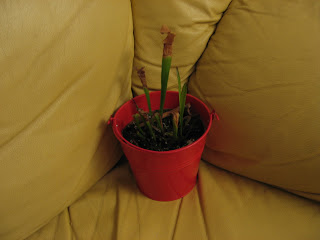This was my very first grow-your-own-edible-stuff experience.
I came across a cheap mushroom growing kit in one of the local supermarkets. It was priced at next to nothing, and the idea seemed funny, so I thought I may give it a try. Worked? Worked! Kinda...
As you can see on the picture above, I've achieved at least partial success. You can grow real giants if you want to!!!
The manufacturer tells you not to let your mushrooms grow bigger than 3-5 cm, but I completely ignored this rule. They grow irregularly, and I didn't really see any point in harvesting a single piece, so I just let it be.
Discovery? There's much more food on a big mushroom than on a small one.
Watching the mushrooms grow was real fun. I'm not sure now how exactly I had imagined the process, but I know that it must have been something different than it is in reality, because I remember being very surprised. Fascinated, too.
This may not be the case with all the kits, but mine did not yield too much crop. I've harvested maybe 10 mushrooms in total. Pictures of white buttons fountaining out of the box will have to remain in the fantasy world, I'm afraid.
I've had a delicious pizza with what I got, though :). Somehow they seemed tastier than shop bought - or is it just grower's pride?
Anyway, this story does not end with happy end. My plantation fell victim to some kind of mould. Even two kinds of mould.
One, whitish, showed up on stumps left after harvested mushrooms. Maybe you're supposed to remove them completely when picking, I don't know, but they tend to cluster and I didn't want to remove three tiny mushrooms when harvesting one grown. So I simply cut them at ground level and soon the mould showed up.
Second is funky blue and entirely my fault, I'm afraid. Don't repeat my mistakes -
DON'T WATER YOUR MUSHROOMS!!
They are supposed to be watered at the beginning of growth process, after that care instructions are silent. My plantation looked very dry, crops somehow diminished and I thought water might help.
Wrong.
The blue mould showed up a day or so afterwards and it doesn't look like disappearing. I've given my mushrooms a chance, thinking that maybe somehow they will clean themselves up, but no joy. Mould grows, mushrooms don't. Hereby I announce today as being an official Goodbye To Mushrooms Day.
There is a silver lining on my mushroom cloud. The kit comes in a handy plastic box that will be a fabulous container for my strawberry plants. That is, when they finally get bigger than a pinhead. But that's another story.








